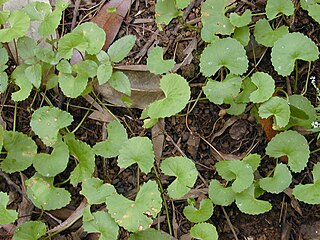
Psoralea is a genus in the legume family (Fabaceae) with 111 species of shrubs, trees, and herbs native to southern and eastern Africa, ranging from Kenya to South Africa. In South Africa they are commonly referred to as fountainbush (English); fonteinbos, bloukeur, or penwortel (Afrikaans); and umHlonishwa (Zulu).

Centella is a genus of 53 species of flowering plants in the subfamily Mackinlayoideae. The genus is sometimes placed in family Araliaceae; however, recent studies utilising molecular data place Centella within Apiaceae.

Lotononis is a genus of flowering plants in the family Fabaceae and the tribe Crotalarieae. The genus includes 99 species of annual and perennial herbs, native to the southeastern Europe and Turkey, eastern Africa, and southern Africa.

Melolobium is a genus of flowering plants belonging to the legume family, Fabaceae. It includes 14 species of small shrubs or perennial herbs native to southern Africa, which are found in southern and eastern Namibia, southwestern Botswana, and most of South Africa.

Amphithalea is a genus of flowering plants in the family Fabaceae. It belongs to the subfamily Faboideae. It includes 41 species endemic to the Cape Provinces of South Africa.

Argyrolobium is a genus of flowering plants in the family Fabaceae. It belongs to the subfamily Faboideae. Members of this genus are found in Africa, western and south Asia, and southern Europe.

Aspalathus is a genus of flowering plants in the family Fabaceae. The yellow flowers and spiny habit of some species have suggested a resemblance to Ulex europaeus, the thorny "English gorse" Accordingly, "Cape Gorse" has been proposed as a common name although the resemblance is largely superficial; for instance, gorse is thorny, whereas Aspalathus species are variously spiny or unarmed. The genus belongs to the subfamily Faboideae. There are over 270 species, mainly endemic to southwestern fynbos regions in South Africa, with over fifty occurring on the Cape Peninsula alone. The species Aspalathus linearis is commercially important, being farmed as the source of Rooibos tea.

Aizoon or Aizoön is a genus of flowering plants in the iceplant family, Aizoaceae.

Hermannia is a genus of flowering plants in the mallow family, Malvaceae. It comprises at least 65 species with many more species as yet unresolved.

Searsia is a genus of flowering plants in the family Anacardiaceae. It includes over 100 species native to Africa, the eastern Mediterranean, Arabian Peninsula, Indian subcontinent, Myanmar, and south-central China.
Polemannia is a genus of flowering plants belonging to the family Apiaceae.
Acrosanthes is a genus of flowering plants in the family Aizoaceae. It is native to the Namibia and South Africa's Cape Provinces in Southern Africa.
Cynorhiza is a genus of flowering plants belonging to the family Apiaceae.
Notobubon is a genus of flowering plants belonging to the family Apiaceae.









